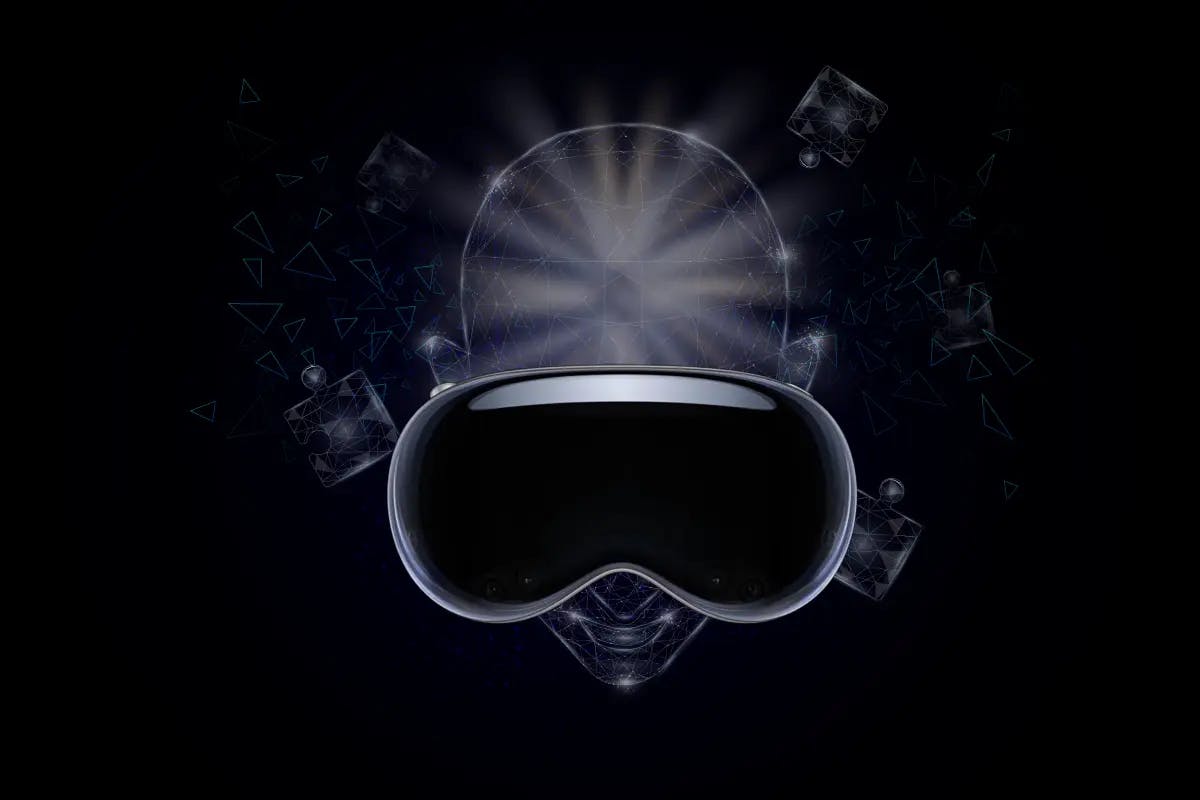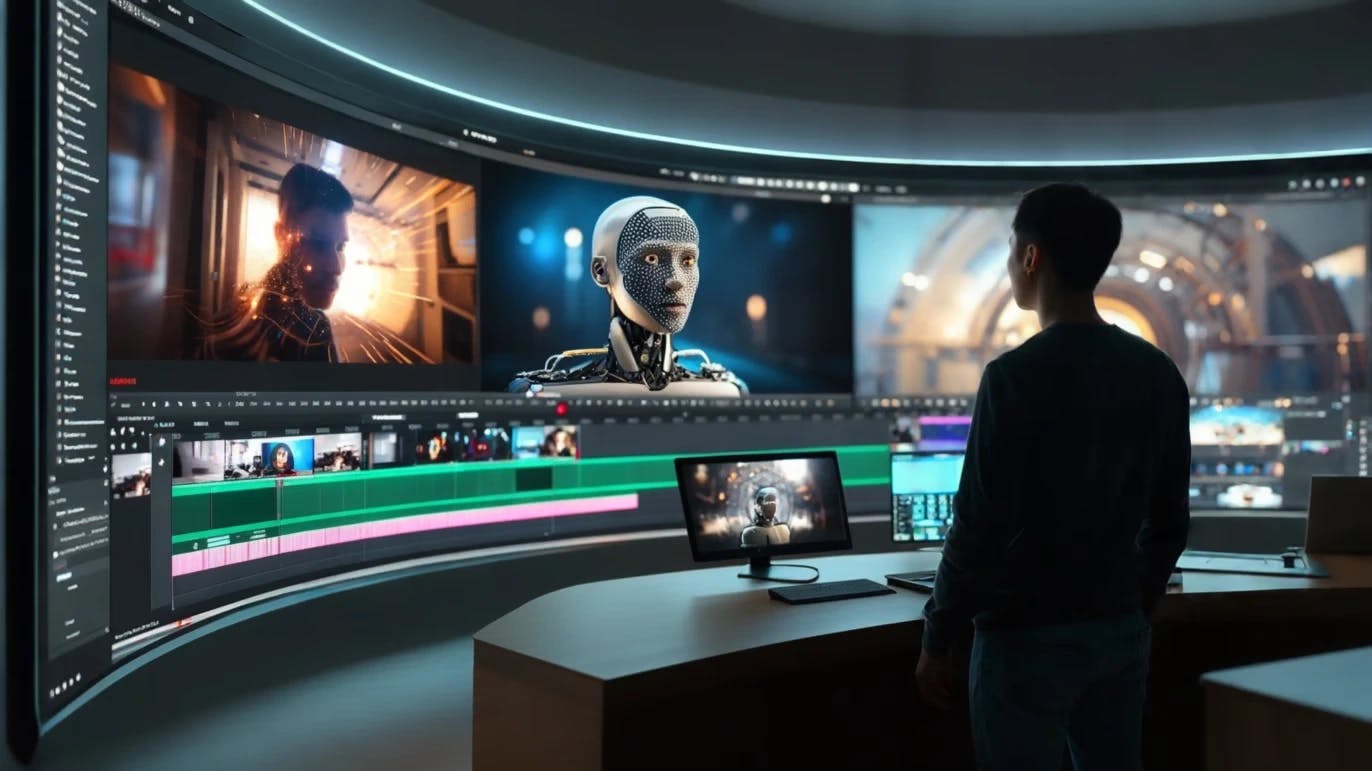Envision a realm where the lines between reality and imagination blend, where your surroundings teem with virtual marvels and intelligent companions. With artificial intelligence and spatial computing glasses, this captivating vision is now within our grasp. In this blog post, we will discuss the potential of AI-driven spatial computing. In this blog post, we will explore the potential of AI-driven spatial computing. From Educational experiences to mind-blowing gaming industries, we will delve into the realms where the tangible and digital converge, uncovering the transformative.
What is Spatial Computing?
Spatial computing is a tech idea that mixes the real world with digital stuff. It uses sensors, screens, and computers to let us play with digital things in real places. It’s like a mix of augmented reality (AR), virtual reality (VR), and mixed reality (MR) to make cool experiences that blend real and virtual things perfectly.
What is Spatial Computing Glass?
Spatial Computing glass also known as augmented reality (AR) glasses or smart glasses, represents a technological advancement in the field of spatial computing. These smart wearable devices have fancy screens, clever sensors, and cool optical tech to mix real and digital things together. Intelligently perceiving the user’s environment and overlaying virtual objects and digital information in real-time, Spatial Computing glass creates immersive and interactive experiences that enhance perception and interaction with the surrounding space.
Sectors such as healthcare, education, architecture, and gaming stand to experience significant changes from spatial computing glass glasses. They can enable hands-free access to vital information, simplify the comprehension of intricate data, and introduce novel methods of communication and interaction. Spatial Computing glasses will be a big change where technology blends smoothly with our real world.
Integrating AI with Spatial Computing Glass
When AI is integrated with Spatial Computing glass, a whole new realm of possibilities emerges. These advanced tech fusion enables the integration of intelligent virtual content with the physical environment and that will enhance our perception and interaction with the world. Spatial Computing glass, with its advanced sensors and displays, provides real-time data on the user’s surroundings, while AI algorithms process this data to deliver personalized and contextually relevant information.
Applications of AI and Spatial Computing Glass
The combination of AI and Spatial Computing glass has the capacity to revolutionize multiple industries and domains. In healthcare, AI can examine patient information and offer instant guidance to doctors. It can also show important details right in a surgeon’s view while they do complex operations. In the education industry, smart AI tutors can guide students through lessons made just for them. They can use special glasses to make learning more exciting and real.
The Synergy Unveiled
When Spatial Computing glasses and AI join forces AI algorithms can utilize the data and context captured by Spatial Computing glasses, generate real-time insights, augment the user’s perception, and provide intelligent recommendations tailored to their environment. This symbiotic relationship enables personalized experiences, enhanced productivity, and improved decision-making, amplifying the capabilities of both technologies.
Applications and Implications
This combination of Spatial Computing glasses with AI is wide-ranging. For instance, in fields like manufacturing, workers using these glasses could get AI-guided directions and visual pointers and that will lead to better productivity and fewer mistakes. In healthcare, AI can quickly examine patient data will sending vital details right to doctors’ glasses. This will help them to diagnose and treat patients faster and with more accuracy.
The convergence of Spatial Computing glasses and AI has transformative implications in fields such as education, gaming, retail, and more. AI-powered virtual tutors can guide students through personalized lessons, adapting to their learning styles and leveraging the immersive capabilities of Spatial Computing glasses. In the gaming industry, AI algorithms can create intelligent and dynamic virtual environments that can respond to user behavior and preferences while Spatial Computing glasses provide a truly immersive and interactive experience.
The Evolution of Spatial Computing Glasses
- Historical Development and Milestones
The evolution of spatial computing glasses has been marked by significant milestones that have shaped their development over some time. The concept of overlaying digital information onto the real world gained momentum with early experiments in the 1960s. The 1980s saw the introduction of wearable computing devices that laid the foundation for the future development of spatial computing glasses. In the 1990s, early augmented reality (AR) headsets emerged, showcasing immersive experiences. The early 2000s witnessed miniaturization and display technologies that will make spatial computing glasses more practical and visually appealing.
In recent years, Apple has made significant advancements in the field. Apple’s launch of the Apple Vision Pro in 2023, a remarkable example has propelled spatial computing glasses into the mainstream market. With sleek designs, powerful processors, and high-resolution displays, these glasses provide users with an immersive and interactive augmented reality experience. This has further accelerated the adoption of spatial computing glasses and opened up new possibilities. - Advancements in Hardware and Display Technologies
Advancements in hardware, software, and connectivity have played a vital role in transforming spatial computing glasses into powerful devices. The miniaturization of components, including processors, cameras, and sensors, has led to lightweight and comfortable wearable devices. High-resolution displays, incorporating advanced optics such as waveguides, provide vibrant and realistic visual overlays. The integration of sensors, including depth sensors, accelerometers, gyroscopes, and compasses, along with simultaneous localization and mapping (SLAM) algorithms, enables precise tracking and spatial mapping of the user’s surroundings. Eye-tracking technology enhances the accuracy of interactions, making spatial computing glasses more intuitive and natural to use.
We can expect further advancements in areas such as improved display technologies, sensor capabilities, and integration of artificial intelligence. These developments will lead to even immersive, intelligent, and seamlessly integrated augmented reality experiences transform various industries and revolutionizing in tech world. - Integration of Sensors and Tracking Capabilities
Spatial computing glasses incorporate a diverse range of sensors and tracking capabilities to achieve high levels of spatial awareness and accurate interaction with the user’s environment. These glasses utilize depth sensors, such as time-of-flight or structured light sensors, to capture precise distance measurements and generate detailed 3D representations of the surrounding objects. By combining this depth information with data from accelerometers, gyroscopes, and compasses, spatial computing glasses can track the user’s movements, orientation, and magnetic fields, enabling real-time adjustments of virtual content to match the physical world.
Simultaneous localization and mapping (SLAM) algorithms are instrumental in spatial computing glasses, as they fuse sensor data with existing maps or environmental features to determine the user’s position and create dynamic spatial maps. This enables accurate placement of virtual objects and occlusion based on real-world geometry. Furthermore, the integration of eye-tracking technology adds another layer of precision and interactivity to spatial computing glasses. By monitoring the user’s eye movements and gaze direction, these glasses can accurately track the user’s focus of attention, allowing for intuitive selection and manipulation of virtual objects.
Through the integration of sophisticated sensors, tracking capabilities, and advanced algorithms, spatial computing glasses achieve a heightened level of spatial awareness. These technical components work in tandem to provide a seamless and immersive augmented reality experience, where virtual content seamlessly interacts with the user’s physical surroundings
Enhancing AI Experiences
- Integration of AI Algorithms and Capabilities into Spatial Computing Glasses
The integration of AI algorithms and capabilities into spatial computing glasses opens up a realm of possibilities for enhanced user experiences and intelligent interactions. These glasses leverage the power of AI to process data, analyze patterns, and make intelligent decisions in real time. By integrating AI at the core of spatial computing glasses, they become capable of performing complex tasks, such as image recognition, natural language processing, and predictive analytics, directly on the device.
AI algorithms running on spatial computing glasses can interpret the data captured by sensors and cameras in real-time. This enables on-device processing and analysis, reducing reliance on external servers and minimizing latency. The integration of AI capabilities enhances the glasses’ ability to understand and interpret the user’s environment, making them more context-aware and responsive. This, in turn, enables personalized experiences, intelligent recommendations, and adaptive interactions tailored to the user’s specific needs and preferences. - Enabling Real-time Object Recognition and Tracking through AI
Spatial computing glasses, enhanced by AI, are equipped with powerful object recognition and tracking capabilities. AI algorithms can analyze the visual data captured by the glasses’ cameras, allowing for real-time identification and tracking of objects in the user’s environment. These glasses can recognize and categorize objects, such as everyday items, landmarks, or specific products, and overlay relevant information or digital content onto them.
Through AI-powered object tracking, spatial computing glasses can maintain a persistent understanding of the user’s surroundings, even as they move and interact with the environment. This enables seamless integration of virtual objects and annotations that accurately align with the physical world, creating a cohesive augmented reality experience. The combination of real-time object recognition and tracking capabilities empowers spatial computing glasses to provide contextual information, interactive guides, and immersive overlays that enhance the user’s perception and interaction with their environment. - Enhancing User Interactions and Experiences with AI-powered Features
AI integration in spatial computing glasses introduces a range of features that enhance user interactions and experiences. Natural language processing capabilities enable voice commands and intelligent voice recognition, allowing users to interact with the glasses using spoken instructions and queries. This enables hands-free operation and intuitive control of the augmented reality content.
Additionally, AI-powered gesture recognition expands the range of interaction modalities for spatial computing glasses. By analyzing the user’s hand movements and gestures, the glasses can interpret and respond to specific gestures, enabling intuitive manipulation of virtual objects or menu navigation. This adds an extra layer of immersion and control to the augmented reality experience.
Furthermore, AI algorithms can learn from user behavior and preferences to provide personalized recommendations and adaptive content. By analyzing user interactions, the glasses can anticipate user needs and surface relevant information or suggestions in real time. This personalized AI-driven experience enhances engagement and productivity, tailoring the augmented reality content to the user’s specific interests and requirements.
Applications of AI in Spatial Computing Glasses
- Augmented Reality experiences with Spatial Computing Glasses
The integration of AI in spatial computing glasses revolutionizes the possibilities for augmented reality experiences. AI algorithms enable advanced computer vision capabilities, allowing the glasses to understand and interpret the user’s environment in real-time. This includes object recognition, scene understanding, and semantic segmentation, enabling the precise overlay of virtual content onto the physical world.
By leveraging AI, spatial computing glasses can enhance the realism and immersion of augmented reality experiences. The glasses can detect and track objects, surfaces, and people, enabling interactive and dynamic augmentations. AI algorithms can also analyze contextual information, such as lighting conditions and environmental cues, to ensure accurate rendering and seamless integration of virtual content. This results in highly immersive and visually compelling augmented reality experiences that merge seamlessly with the user’s surroundings. - Virtual Assistants and Voice Recognition in Spatial Computing Glasses
AI brings the power of virtual assistants and voice recognition to spatial computing glasses, creating a hands-free and intuitive user experience. AI algorithms enable natural language processing and voice recognition capabilities, allowing users to interact with the glasses using spoken commands and queries. The glasses can understand and interpret voice inputs, perform speech-to-text conversion, and execute corresponding actions or provide relevant information.
AI-powered virtual assistants integrated into spatial computing glasses act as intelligent companions, capable of understanding context and providing personalized assistance. They can answer questions, provide recommendations, and perform tasks based on user commands. The glasses’ voice recognition capabilities ensure accurate and seamless communication, enhancing the user’s ability to interact with the augmented reality environment effortlessly. - Personalization and Adaptive Content Delivery in Spatial Computing Glasses
AI plays a crucial role in personalizing the content and experiences delivered through spatial computing glasses. By analyzing user data, preferences, and behavior, AI algorithms can dynamically adapt and tailor the augmented reality content to individual users. This enables personalized recommendations, adaptive interfaces, and contextual information delivery.
AI-powered personalization in spatial computing glasses enables the glasses to learn from user interactions and adjust the augmented reality content to meet specific needs and preferences. The algorithms can anticipate user requirements, surface relevant information, and optimize the display of virtual content based on the user’s context and preferences. This creates a highly tailored and engaging experience, enhancing user satisfaction and productivity.
Advantages of Combining AI and Spatial Computing Glasses
- Improved Contextual Understanding through AI-powered Data Analysis
The combination of AI and spatial computing glasses offers improved contextual understanding by leveraging AI-powered data analysis. AI algorithms can analyze vast amounts of data collected by the glasses’ sensors, including visual, spatial, and environmental information. Through advanced computer vision techniques, AI can interpret and extract meaningful insights from this data, providing a deeper understanding of the user’s surroundings.
Processing and analyzing sensor data in real-time, AI algorithms can identify objects, recognize patterns, and extract relevant contextual information. This enhanced contextual understanding enables spatial computing glasses to deliver accurate and contextually relevant augmented reality content. Users can benefit from precise overlays, intelligent object recognition, and context-aware information delivery, resulting in a more seamless and immersive augmented reality experience. - Enhanced User Productivity and Efficiency with AI Assistance
The integration of AI in spatial computing glasses brings valuable assistance and enhances user productivity and efficiency. AI-powered algorithms can assist users in various tasks, providing intelligent suggestions, real-time guidance, and automated processes. This assistance eliminates the need for manual intervention and enables users to accomplish tasks more efficiently.
AI algorithms can analyze user behavior, preferences, and contextual data to offer personalized recommendations and optimize workflows. This results in streamlined interactions and faster decision-making processes. Spatial computing glasses equipped with AI can provide contextual information, step-by-step instructions, and proactive support, empowering users to complete tasks with greater ease and efficiency
Challenges and Considerations
- Technical limitations
Spatial computing glasses face technical limitations in terms of computational capabilities and power efficiency when running AI algorithms. Improving hardware performance and optimizing algorithms are ongoing challenges. - Privacy Concerns
The use of AI in spatial computing glasses raises privacy concerns due to the collection and processing of personal data. Data security measures, user consent, and transparency in data usage are necessary to protect user privacy. - Ethical Considerations
Ethical considerations arise in the integration of AI in spatial computing glasses. Ensuring fairness, minimizing biases, and addressing potential societal impacts are important ethical considerations.
Future Trends and Possibilities
- Predictions for the Future of AI-powered Spatial Computing Glasses
The future of AI-powered spatial computing glasses holds immense potential for transformative advancements. Predictions include the development of even more compact and lightweight glasses with enhanced processing capabilities. AI algorithms will continue to enable advanced computer vision, natural language processing, and machine learning capabilities.
Future spatial computing glasses may integrate additional sensors and technologies, such as eye-tracking, gesture recognition, and haptic feedback to further enhance user interactions and experiences. The seamless integration of AI and spatial computing will lead to intuitive and immersive augmented reality experiences. - Emerging Technologies and Advancements Shaping the Field
Several emerging technologies are shaping the field of AI-powered spatial computing glasses. These advancements include display technologies, such as holographic displays and waveguide displays, which offer improved visual quality and a wider field of view. Progress in sensor technologies, such as LiDAR and depth-sensing cameras, it will enable accurate and detailed environment mapping.
Advancements in edge computing and cloud-based AI processing allow for more complex AI algorithms to be executed on spatial computing glasses, reducing latency and enhancing real-time capabilities. Additionally, the integration of 5G and high-bandwidth connectivity enables seamless data transfer and cloud interactions to collaborative and cloud-assisted applications. - Potential Impact on Industries
AI-powered spatial computing glasses have the potential to greatly impact industries such as healthcare, gaming, and education. In healthcare, these glasses can improve patient care through real-time access to data, surgical guidance, and augmented reality visualizations for training. In gaming, they can create immersive experiences by seamlessly blending virtual elements with the real world. In education, these glasses can transform learning with interactive content, simulations, and personalized guidance, enhancing the overall educational experience. Overall, the integration of AI and spatial computing glasses has the power to revolutionize these industries and bring about significant advancements.
Conclusion
The fusion of Spatial Computing glasses and Artificial Intelligence represents a monumental technological leap forward. By blending physical and digital realms, these glasses provide users with immersive and interactive experiences that were once confined to the realm of science fiction. The integration of AI algorithms and capabilities enhances the glasses’ functionality, making them context-aware, intelligent, and capable of delivering personalized content.
Real-time object recognition and tracking, AI-powered spatial computing glasses amplify our perception and interaction with the world around us. Natural language processing, gesture recognition, and personalized recommendations further elevate the user experience, opening up new possibilities in healthcare, education, gaming, manufacturing, and beyond. This powerful combination has the potential to revolutionize industries, empowering individuals with enhanced capabilities and transforming the way we engage with our environment.
We at Codiste a Pioneers in the Development of Spatial Computing Glasses, merging the physical and digital worlds seamlessly. Our AI-powered glasses provide immersive and interactive experiences, enhancing object recognition, gesture control, and personalized recommendations. With transformative applications in healthcare, education, gaming, and manufacturing, we empower industries to revolutionize their processes. Join us in a new era where technology integrates harmoniously with our physical reality. Contact us now!






